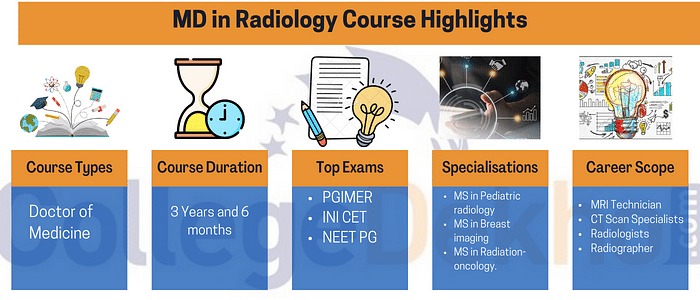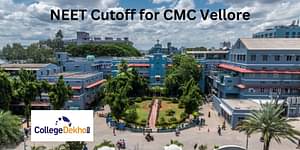MD Radiology
Course Overview
Doctor of Medicine or MD in Radiology is a postgraduation degree in radiology. The duration of this program is 3 years. Candidates can pursue the course after they have completed their 5 years MBBS degree or graduated in medical science or a relevant field along with appropriate work experience. Radiology or medical imaging is the branch of medical science that involves studying the anatomical structure of living things by using x-rays and other high-energy radiations. It diagnoses diseases in several parts of the body by taking medical images. In India, there are many major entrance exams that are conducted as part of the admission process for students. Exams like NEET-PG are held at the national level to grant candidates admission to MD in Radiology courses in any college all over India.
MD in Radiology program is conducted as a full-time offline course. Many colleges in India offer MD in Radiology degrees to their students. CMC Vellore, AIIMS New Delhi, AFMC Pune, KPC Medical College & Hospital Kolkata, and DYPMC Pune are some examples. In India, the average course fee for this course ranges between 40,000 to 8,00,000 INR per annum. There are a lot of designations such as radiographers, Radiologists, etc., that candidates with an MD in Radiology degree can start working on after completing the course.
Table of Contents
- Course Overview
- Course Highlights
- Why Choose MD in Radiology?
- Entrance Exams for MD in Radiology:
- Eligibility Criteria For MD in Radiology
- Admission Process For MD in Radiology
- Popular Colleges in India For MD in Radiology
- Popular Colleges Abroad For MD in Radiology
- Colleges In India For MD in Radiology (State And City-Wise)
- Course Fee For MD in Radiology
- Syllabus of MD in Radiology
- Subjects Of Study Under MD in Radiology
- Best Books for MD in Radiology Course
- Career Scope in India After MD in Radiology
- Skills Required For MD in Radiology
- FAQs about MD Radiology
Course Highlights

The major points about MD in Radiology are pointed out below to help interested students get an idea of the course:
| Course name | Doctor of Medicine or MD in Radiology |
|---|---|
| Course Level | Postgraduation |
| Duration | 3 years |
| Mode of examination | Semester |
| Entrance Exams | AIIMS-PG, NEET-PG |
| Eligibility | MBBS and a 1-year internship |
| Average Course Fee | 50,000 to 8,00,000 INR |
| Average Salary | 15,00,000 to 21,00,000 INR |
| Top Recruiters | Apollo Super Speciality, AIIMS |
| Designations | Radiologist, CT Scan Technologist, MRI Technician, and Healthcare for military veterans. |
Why Choose MD in Radiology?
Radiology is an important stream of medical science. It helps in diagnosing and treating diseases at an early stage. Candidates can choose this area of the profession because the demand for radiologists has been there since the beginning and this will never decrease in the future. Besides, there are plenty of job opportunities both within and outside India with high compensation. Unlike other medical practitioners, radiologists start earning just after completing their degrees. Radiologists are needed in every medical establishment. There are plenty of private and government job opportunities for people with an MD in Radiology degree. Also, there are many research options available in this degree course. Many fellowships and grants are also presented to students of MD in Radiology. Individuals who have a knack for using modern medical technology to help patients and assist doctors can choose this field of medical education.
Entrance Exams for MD in Radiology:
Several entrance exams are held for the purpose of admission to MD in Radiology courses. Some of them are
NEET-PG: This exam is conducted once a year. Students get a total time limit of 3 hours and 30 minutes. The entire test is conducted in Computer-based mode. There are a total of 300 questions and for each correct answer, students are given 1 mark. There is no negative marking in this exam. Passing this exam makes a candidate eligible for admission to any medical college in India for pursuing their postgraduation degree.
INI CET: This entrance test is conducted twice every year for all the students who want to finish their postgraduate or doctorate-level degrees from AIIMS. Passing this test makes a student eligible for admission to any of the AIIMS institutions in India. The test contains 200 multiple-choice questions, covering the entire MBBS syllabus.
PGIMER: This examination is held as an admission criterion for students who wish to pursue their MD in Radiology from the Post Graduate Institute of Medical Education and Research in Chandigarh. The questions for this entrance test are also multiple-choice based. Students are given a total time limit of 3 hours.
Eligibility Criteria For MD in Radiology
The regulatory boards of the nation have set some minimum admission requirements for students who wish to continue their MD in Radiology course. Some of the basic criteria for admission to this course are discussed below:
-
Students must complete their 10+2 level education in the science stream, with biology and chemistry as major subjects. They must also obtain a minimum of 60% aggregate from any recognized institution.
-
After that, the aspirants have to take admission and complete their 5-year MBBS degree or any other similar degree in medical science.
-
They should obtain at least 55% in their aggregate in their MBBS degree.
-
Students need to complete their 1-year in-house internship during their MBBS course.
-
Related work experience is a plus point in this case.
-
Candidates need to sit and pass the NEET-PG or any other designated entrance exams with the qualification marks stated as per the regulatory body.
-
For students who wish to complete their MD in Radiology from foreign countries, need to produce their ILETS or TOEFL certificates.
Admission Process For MD in Radiology
All the students who want to take admitted to MD in Radiology course, must sit for and clear the entrance exams with requisite marks. Besides NEET-PG, which is held at the national level, all the medical colleges and research centers hold their own entrance examination. The syllabus for all the entrance examinations is more or less the same. The entire syllabus of MBBS is covered while framing the questions for the test. After the examination, a personal interview session is held with the qualified students where the college board members look for the skills and work experience of the candidate. A group discussion session is also held with qualified students. The students must keep in mind that they need to secure 55-60% aggregate marks in their High Secondary level as well as at their graduation level.
Popular Colleges in India For MD in Radiology
Some of the famous colleges in India that offer MD in Radiology are:
COLLEGE NAME |
COURSE FEES |
|---|---|
|
Christian Medical College |
3,00,000 to 4,00,000 INR |
|
Karnataka Institute of Medical Science |
1,00,000 to 1,40,000 INR |
|
Bharti Vidyapeeth Medical College |
50,000 to 75,000 INR |
|
University College of Medical Science |
50,000 to 80,000 INR |
|
KS Hedge Medical Academy |
1,00,000 to 2,00,000 INR |
|
AFMC Pune |
30,000 to 55,000 INR |
|
Kasturba Medical College |
2,55,000 to 4,55,000 INR |
|
JSS Medical College |
5,00,000 to 8,00,000 INR |
|
MS Ramaiah Medical College |
6,00,000 to 10,00,000 INR |
|
St.John Medical College |
3,00,000 to 5,55,000 INR |
|
Rajendra Medical College |
1,00,000 to 1,70,000 INR |
|
Bhaskar Medical College |
2,50,000 to 5,00,00 INR |
|
Kurnool Medical College |
50,000 to 55,000 INR |
Popular Colleges Abroad For MD in Radiology
MD in Radiology is one of the most sought-after courses outside India. Each year, thousands of Indians send their admission application to colleges across the globe. Here are some of the popular choices of colleges for MD in Radiology courses:
COLLEGE NAME |
LOCATION |
|---|---|
|
Imperial College of London |
United Kingdom |
|
Harvard University |
United States of America |
|
King’s College |
United Kingdom |
|
McMaster University |
Australia |
|
University of California |
United States of America |
|
University of Toronto |
Canada |
|
University of Sydney |
Australia |
|
Heidelberg University |
Germany |
|
Stanford University |
United States of America |
|
National University of Ireland Galway |
Ireland |
|
Cardiff University |
United Kingdom |
|
Trinity College |
Ireland |
Colleges In India For MD in Radiology (State And City-Wise)
Several colleges are present in India that provide MD in Radiology. The state-wise allocation for the best choices of colleges for students to complete their MD in Radiology is listed below:
Telangana |
|
|---|---|
|
College/University |
City |
|
Hyderabad |
|
|
Hyderabad |
|
|
Hyderabad |
|
|
Mahbubnagar |
|
Delhi |
|
|---|---|
|
College/University |
City |
|
New Delhi |
|
|
New Delhi |
|
|
Baba Saheb Ambedkar Technical Education Society |
New Delhi |
|
New Delhi |
|
West Bengal |
|
|---|---|
|
College/University |
City |
|
Kolkata Medical College |
Kolkata |
Karnataka |
|
|---|---|
|
College/University |
City |
|
St.John’s Medical College |
Bangalore |
|
Raja Rajeswari Medical College |
Bangalore |
|
Bangalore |
|
|
VIMS |
Bangalore |
Maharastra |
|
|---|---|
|
College/University |
City |
|
Mumbai |
|
|
Tata Memorial Hospital |
Mumbai |
|
MGM Medical College |
Mumbai |
|
Sevagram |
|
|
Byramjee JeejeebhoyGovernment Medical College |
Pune |
|
Grant Medical College |
Mumbai |
|
J.J. Group of Hospitals |
Mumbai |
|
Dr. Vaisampayan Memorial Government College and Research Institute |
Solapur |
|
ACPM Medical College |
Dhule |
|
Dr. D.Y.Patil Medical College and Research Institute |
Pune |
|
MGM University of Health Sciences |
Navi Mumbai |
|
Bombay Hospital Institute of Medical Science |
Mumbai |
Gujarat |
|
|---|---|
|
College/University |
City |
|
Ahmedabad |
|
|
C.U Shah Medical College |
Surendra Nagar |
|
Surat Government Medical College |
Surat |
|
Pramukhswami Medical College |
Anand |
|
Bhuj |
|
|
Vadodara |
|
|
Vadodara |
|
Course Fee For MD in Radiology
The course fee for private colleges is higher than the government or public medical colleges. It varies from one college to another. The average fee range for MD in Radiology course in India lies between 5,00,000 to 20,00,000 INR. For government colleges, this course fee is much lesser with the average fee ranging from 50,000 to 4,00,000 INR. The course fee for the MD in Radiology degree is set by the respective colleges and is dependent upon some factors like; infrastructural facilities, faculty members, laboratory equipment quality, etc.
Syllabus of MD in Radiology
The syllabus format for MD in Radiology is given below:
Semester 1 |
Semester 2 |
Semester 3 |
Semester 4 |
Semester 5 |
Semester 6 |
|---|---|---|---|---|---|
|
Production of Xrays |
Musculo– skeletal system |
Fluoroscopy |
Imaging of Obstetrics |
Radiation Biology |
Radiation protection |
|
Interaction of radiation with matte |
Cardiovascular system |
Special Radiography |
Gynecology |
Guidelines for safe work practice |
Endocrine System |
|
Radiography Medical Radiation |
Gastrointestinal system |
Nuclear Medicine |
CNS Including Spine Urogenital tract |
MRI |
Ultrasonogram |
|
Physics as applied to Radio – Diagnosis |
Respiratory system |
Interaction of radiation with matter |
Radiopharmaceuticals |
- |
- |
Subjects Of Study Under MD in Radiology
The core subjects that the candidates learn during their MD in Radiology degree are as follows:
Basic Concepts- It contains all the basic ideas that a student needs to have before starting to study the core subjects of radiology. Basic definitions are taught under this title. Other study area includes topics like the structure of an atom, electromagnetic radiation, atomic nucleus, radioactivity, nuclear fission, and fusion.
Production of X-rays- Under this subject, students learn about the basics of X-Rays, their source of production, the quality of X-Ray beams and their intensity, and the interaction of these beams with their targets.
Interaction of Radiation with Matter- This is a very vital area of study under a radiology degree. Under this, students learn about particle and photon interactions, the photoelectric effect of coherent scattering, usage, and the importance of pair production. Alongside these, the students also learn about attenuation and the factors affecting it. Students are introduced to the concept of Diagnostic Radiography in this subject area.
Radiography- Students get acquainted with the basic dynamics of radiography. The various components of radiography like cassettes, film screen radiography, digital radiography, and scattered radiation are taught. Also, students learn about the basics of grids and their characteristics. Various types of Grids like; Grid artifacts, moving grids, filters, air gaps, cones and cylinders, and collimators are also covered.
Fluoroscopy- The topics that are covered under this include; positioning, real-time imaging, and general principles. Students are also taught about the usage of photo spot cameras. The usage of fluoroscopic equipment and optimal coupling is also taught in this subject.
Special Radiography- The most important topic covered under this is Stereo Radiography, its history, and development over the years. The various aspects of mammography and computer tomography are also covered during the course. Also, the recent developments in radiology are elaborately discussed under this title.
Modern Imaging System- This includes a study about ultrasound, its basic concept, production, and interaction of ultrasound with other matters. Students also get acquainted with important topics like reconstruction techniques, image acquisition, biological safety, MRI Instrumentation, and Magnetic Resonance Imaging.
Nuclear Medicine- This is one of the vital subjects of the MD in Radiology course. Here, the concepts of radioactivity, radiation detector thyroid probe, Augar scintillation camera computers in Nuclear imaging, Radionuclide production, and Radiopharmaceuticals are discussed elaborately. Also, students are introduced to the concept of nuclear tomography.
Radiation Biology- Under this topic, the biological effects of radiation, Cellular radio, responses of organs to radiation, and acute radiation syndrome are elaborately taught to the students. All the recent research and studies conducted on this topic are introduced to the students.
Radiation Protection- Here, students learn about natural radiation and its occasional exposure. They are taught about how to control radiation, time, barriers, and protective barrier specifications. Also, aspirants are taught about the basic guidelines to maintain a safe workplace, the regulatory agencies, Atomic Regulatory Agency Board, and several radiation protection rules in India.
Best Books for MD in Radiology Course
Some of the best books that students can refer to for their MD in Radiology degree coursework are :
- Learning Interventional Radiology
- Image-Guided Interventions: Expert Radiology Series
- Interventional Radiology: A Survival Guide
- IR Playbook: A Comprehensive Introduction to Interventional Radiology
- Pocketbook of Clinical IR: A Concise Guide to Interventional Radiology
- Fundamentals of Radiology.
- General Radiology.
- Chest Radiology.
- Imaging Anatomy.
- Body Imaging.
- Gastrointestinal Radiology.
- Musculoskeletal radiology (MSK)
Career Scope in India After MD in Radiology
Candidates who have completed their MD in Radiology have a great scope and career opportunities in India with a great compensation range. Some of the career choices are given below:
| DESIGNATION | JOB DETAILS | AVERAGE SALARY |
|---|---|---|
| CT Scan Technologists | Operate the pieces of machinery that scan and detect the location and condition of a patient’s tumor | 5,00,000 to 6,70,000 INR |
| Radiographers | They handle the task of managing and operating the machinery that is necessary to get medical images. | 10,00,000 to 17,00,000 INR |
| MRI Technician | They handle and operate the magnetic resonance machines that are used to obtain medical images. | 17,00,000 to 22,00,000 INR |
| Radiologists | They are registered medical professionals and use medical imaging, X-Rays, nuclear medicines, magnetic resonance, etc. to treat diseases in patients | 20,00,000 to 30,00,000 INR |
Skills Required For MD in Radiology
To become an expert in this field of study, a certain skill set is desirable.
- Possess the ability to conduct research for the necessary development in this field. More and more efficient research work will make the field more modern and updated.
- Should have the ability to skilfully handle any problematic situation. Many times at any medical establishment, problems can arise with either patients or pieces of machinery. They need to handle those situations properly.
- Candidates should have sound knowledge and clear concepts about the subject. Having a clear concept of all the fields of MD in Radiology can help professionals handle any medical situation effectively.
- Basic medical knowledge is a must for professionals in this field. This is a desirable skill as all of the candidates have to pass MBBS before becoming eligible for MD in Radiology.
- Some situations may require candidates to demonstrate or even train their juniors or assist other medical practitioners along with their diagnosis. So, they must have the skill to conduct training sessions whenever required.
FAQs about MD Radiology
Do I need a science background for this field?
Yes. It is the minimum admission requirement for all students to have a science stream background with physics or biology as their major papers in the higher secondary school level.
Are entrance exams for DM in Radiology compulsory?
Yes. It is a compulsory admission criterion for this course. Most universities have their entrance exam. Some exams like NEET-PG are conducted on a national level for admission of students to MD Radiology courses.
What diseases do radiologists treat?
Radiologists can treat many diseases and also help to detect many disorders with the help of X-rays and other medical imaging. Some major disorders treated by Radiologists are; Alzheimer's, Dementia, Anemia, Appendicitis, Pneumonia and chronic obstructive pulmonary disease (COPD), Blood clots, peripheral artery disease (PAD), etc.
What is the average fee for an MD Radiology course?
In India, the average fee for an MD Radiology course is 2,00,000 to 22,00,000 INR. the salary of these professionals depends upon several factors like the total work experience of the person, his/her achievements, job location, highest qualification of the person, etc.
Are Radiologists called doctors?
Radiologists are given the term ‘specialist doctors’. They treat patients with the help of medical images. They also assist doctors and other medical practitioners in detecting and diagnosing many diseases inside the organs.
Does radiologists do surgery?
No. They do not perform surgeries but they assist in surgical procedures they assist the surgeons during many critical surgeries by medical imaging. This helps in detecting the affected body organ easily.
Which stream is best for radiology?
The best stream for radiology is a science with either a biology or physics subject as a major at the graduation level. An MBBS degree or any relevant degree in medical studies is also best suited for this course.
How many years does one require to become a radiologist?
After completing high school, a person needs 13 years to become a certified radiologist.
What are the 4 types of medical imaging?
The 4 major types of medical imaging are
- Ultrasound Imaging.
- Magnetic Resonance Imaging
- Pediatric X-ray Imaging.
- Medical X-ray Imaging.
What are the three major branches of radiology?
The three major branches of radiology are:
- Medical Radiology.
- Surgical Radiology.
- Cellular Radiology.
Related Questions
Popular Courses
- Courses
- MD Radiology


















